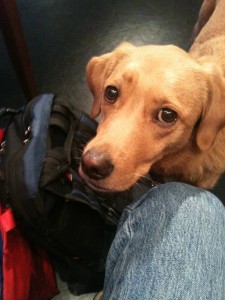We are under pressure. Our dog’s behavior is dangerous. We need to change it. We’re in a hurry. We have no time. The only comfort we have, if there is any to be found, is that we are not alone. So many of us taking on complicated dog behavior problems get tripped up. We flail and sometimes feel like we are drowning in despair.
I’ve written elsewhere about the process of dog training and how we solve common dog behavior problems. We’ve also talked about the illusion of control in dog training and our human tug towards punishment in training. What I haven’t addressed head on, until now, is the basic human life skill at the root of excellent teaching and learning – at the root of life, in fact. Breathing.
You might have guessed by now that I’m not talking about that shallow in-and-out that keeps us upright. It’s not the gasping and sighing we do while we prattle off commands to our dogs either. No, I’m talking about mindful breathing. It’s the take-a-breather, focus on your body, draw it in, let it out slowly, stay in the moment kind of breathing. Breathe. Notice your lungs pulling in the air. Relax your belly, then fill your chest. Pay attention while you let it out.
In.
Out.
This is the breathing you’ve done in yoga class, or at least tried. It’s the foundation of meditation. It’s part of prayer and contemplation in every religion (the root of the word “spirit” is breath). Breathing, real attentive breathing is at the heart of who we are as humans. It certainly plays a role in our relationship and our ability to communicate with our dogs. Here’s how.
Breathe to prepare your mind for teaching your dog. Take five minutes. Sit quietly and focus on the in and out of your breath. This is a simple and short meditation. That word scares some people, I know. Breathe. You know how to do it. In. Out. The idea is to focus on one thing for a short period of time. Your breathing. You’re breathing.
 I sometimes cheat. My focus becomes watching my dog as I breathe. There is no talking, simply observing and breathing. I’ve caught Stella looking back at me and we’ve held that observant vigil for minutes on end – long enough for me to get lost in it, awakened only by the tear tracking down my cheek. (I’m a sap, it’s true). Watch. Breathe.
I sometimes cheat. My focus becomes watching my dog as I breathe. There is no talking, simply observing and breathing. I’ve caught Stella looking back at me and we’ve held that observant vigil for minutes on end – long enough for me to get lost in it, awakened only by the tear tracking down my cheek. (I’m a sap, it’s true). Watch. Breathe.
Breathe while you teach. So much of what you and I are doing with our dogs is about modeling calm behavior. Mindful breathing helps us do that. Focus on the process of training, yes. Observe your skills and how they affect your dog’s behavior in the learning session, definitely. But, don’t forget to breathe. That remembrance will keep you connected to your body and your mind space. Are you tense? Are you losing patience? Are you okay? Take care of yourself. The teaching and learning will come more easily if you breathe.
I sometimes take a mini-breather while training. It’s easy to do when switching between exercises. I especially like to do that if I’m going to transition from clicker training to a play break. Remembering what I’m doing and breathing through it helps me smile in learning sessions. That keeps me connected to my dog and the work we’re doing together. It fuels the fun and the joyful praise in the moment.
 Breathe in the space in between. So often we are caught in the illusion that learning and teaching are only things that happen in “sessions.” Take just a second, or a minute, or two. Then take a breath. Look at your dog. Is she looking back? Raise your eyebrows and say “hello.” It’s such a powerful moment. If she comes to you, pet her. Let everything else that is happening fall away (It will be there when you get back). Breathe through this experience with your dog.
Breathe in the space in between. So often we are caught in the illusion that learning and teaching are only things that happen in “sessions.” Take just a second, or a minute, or two. Then take a breath. Look at your dog. Is she looking back? Raise your eyebrows and say “hello.” It’s such a powerful moment. If she comes to you, pet her. Let everything else that is happening fall away (It will be there when you get back). Breathe through this experience with your dog.
Not just sometimes, but every day I sit on the floor with my dogs and let them come to me. I don’t talk. I breathe with them, and touch, and nuzzle. I do this even after very long days with everyone else’s dogs. It connects me to Stella and Stewie. It also reminds me of how I’m connected to my clients – all dealing with the stressors and the drama life – none of us really alone – keeping our heads above water. All of us, when we can, remembering to breathe.
Michael Baugh teaches dog training in Houston TX. He specializes in dogs who behave aggressively and fearfully.



